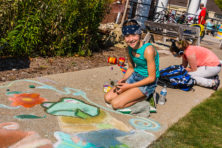Chalk Artists Plan Door County Piece for Harvest Festival
- Share
- Tweet
- Pin
- Share

When Craig and Jamie Rogers began preparing for the new school year in the Richland Center School District, they stocked their art classrooms with the typical supplies: crayons, markers and colored pencils. But there’s another carefree medium they added to their classroom collection, and it happens to be one that dominates their school-free summers: chalk.
For the past seven years, Craig and Jamie have spent their summers traveling the state in pursuit of festivals and competitions to show off their chalk art prowess. Working under the name Rogers’ Creations, they have won awards for their colorful, layered and ethereal chalk nature and portrait drawings.
The duo makes their way north this weekend to create a special chalk piece at Sturgeon Bay’s Harvest Festival as part of the inaugural Chalk the Bay! community chalk art event on Third Avenue and near the Door County Library.
I recently caught up with Jamie and Craig to talk about their chalk art creations and the challenges of this medium. For more of their impressive works, find “Rogers’ Creations” on Facebook.

Craig Rogers works on a chalk portrait at the Museum of Wisconsin Art’s inaugural Art & Chalk Fest in July 2017. Submitted photos.
Alyssa Skiba (AS): How did you discover chalk art?
Craig Rogers (CR): I graduated from college and got my first job at D.C. Everest [School District], Wausau area, and we just happened upon the chalk festival that they have there and thought it was the coolest thing we’d ever seen. There were hundreds of artists that were on their hands and knees playing with chalk. We were completely overwhelmed and excited on how did we never see this or hear of this? It was super cool so we had to do it the next year and then we were just hooked. That was seven years ago.
AS: What’s the process of creating a piece?
CR: First we kind of build our idea, brainstorm a little bit and then we draw some sketches of some different angles and some different compositions and then from there we go online and actually find bits and pieces of things that we like, so maybe the eyes of one person, the mouth of another person or the hair of another person and then we collage them all together. If there are animals, we find different animals and habitats and then collage those all together then we put them through filters and then we finally take that image, print it out, put a grid over it if we’re going to grid, then we make our chalk drawing look better than our picture.
AS: What is the division of labor in your collaboration?
CR: She is the guru of color. I do all the drawing and meticulous line work, and she gets to play with all the pretty colors.
AS: What are the biggest challenges of the medium?
Jamie Rogers (JR): You definitely are on your knees for a long period of time, hunched over in a position that you’re normally not in for very long. There’s a little bit of stress on your body of course but when we put the chalk down, we rub it in with our fingers so your fingers start to feel it…Those are things that are little annoyances but the biggest thing is watching for dark clouds and if it’s going to be a complete wash and it’s only a one-day event then we just try to hustle and get as much done as possible but if it’s a two-day event, you kind of have to judge when the rain might open up then you have to cover your piece and you can’t work on it anymore that day and hope that the rain is not coming back tomorrow.
AS: How do you continually challenge yourselves as chalk artists?
JR: That’s the big reason why we do portraits because faces are very recognizable…it’s pretty obvious when you get it wrong. That’s a big challenge for us to make sure that we’re being really accurate with faces and then also making up our own faces and making sure that they have good emotion and something that’s going to register with an audience I think is for sure a big challenge. Besides that we also look into the aspect of anamorphic perspective, which is something that a lot of people know when they think of chalk art, they immediately think of the holes in the sidewalk that looks like something’s popping out of them. That idea that it looks 3D.
AS: What place do you think chalk has in the art world?
JR: I think a lot of people that go to events and participate are people that possibly don’t feel that they are artists but they go and say, ‘It’s chalk art, I did it when I was young, I bet you I can do it again.’ The idea that it’s this once-a-year event for a lot of towns is that they can relive the childhood material and the idea of elevating it a little bit further and spending more time on it. It’s something that the average person can do and feel comfortable doing, and they can continue building on that skill year after year. If it doesn’t turn out perfect, it’s okay because it’s going to wash away and they can try again next year to do better.




